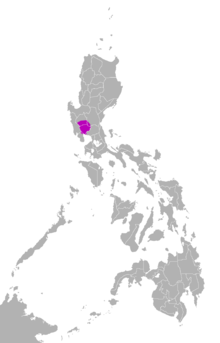Kapampangan language
Appearance
| Kapampangan | |
|---|---|
| Pampangan | |
| Amánung Kapampangan, Amánung Sísuan | |
 "Kapampangan" written in Kulitan, the native writing system of the language | |
| Pronunciation | [kapamˈpaŋan] |
| Native to | Philippines (Central Luzon) |
| Region | Pampanga, southern Tarlac, northeastern Bataan, western Bulacan, southwestern Nueva Ecija and southeastern parts of Zambales |
| Ethnicity | Kapampangan people |
Native speakers | 2.4 million (2010)[1] |
| Dialects | |
| Latin (Kapampangan alphabet) Historically written in: Kulitan | |
| Official status | |
Recognised minority language in | Regional language of the Philippines |
| Regulated by | Komisyon sa Wikang Filipino |
| Language codes | |
| ISO 639-2 | pam |
| ISO 639-3 | pam |
| Glottolog | pamp1243 |
 | |
The Pampangan language or Kapampangan is one of the main languages of the Philippines. It is predominantly spoken in the province of Pampanga, and most parts of Tarlac towns in Bamban, Capas, Concepcion, La Paz and Tarlac City and Bataan.
References
[change | change source]- ↑ Kapampangan at Ethnologue (18th ed., 2015)
Other websites
[change | change source] Pampanga edition of Wikipedia, the free encyclopedia
- Bansa Kapampangan-English Dictionary Archived 2016-11-19 at the Wayback Machine
- Kapampangan Wiktionary
- 10 ICAL Paper – Issues in Orthography
- 10 ICAL Paper – Importance of Diacritical Marks
- 10 ICAL Paper – Transitivity & Pronominal Clitic Order
- Austronesian Basic Vocabulary Database Archived 2017-05-03 at the Wayback Machine
- Electronic Kabalen – New Writing on Kapampangan Life & Letters
- Dying languages Archived 2009-03-02 at the Wayback Machine
- State can still save Kapampangan Archived 2007-10-07 at the Wayback Machine
- Wikibook Kapampangan
- Siuala ding Meangubie
- Online E-book of Arte de la Lengua Pampanga by Diego Bergaño. Originally published in 1736.
